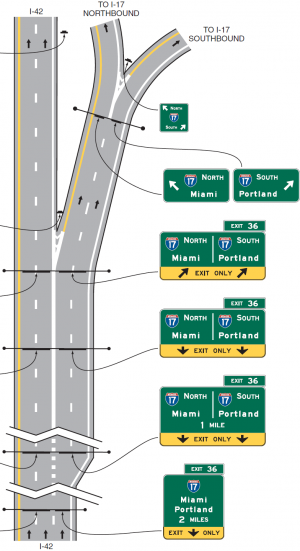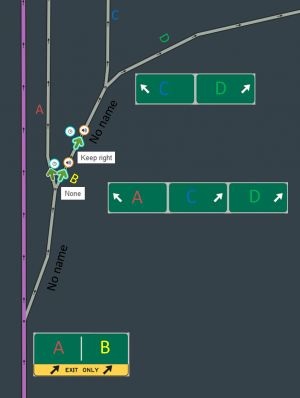(add fork US model, to adapt) |
|||
| Line ١٣: | Line ١٣: | ||
**> [element] / [element] ''(as needed)'' | **> [element] / [element] ''(as needed)'' | ||
**''e.g.'', > Hamad Int'l Airport / Sabah Al Ahmad Corridor | **''e.g.'', > Hamad Int'l Airport / Sabah Al Ahmad Corridor | ||
==== Ramp fork naming ==== | |||
Naming of ramp forks should generally follow the guidelines from [[Road names#Exit|road names]], but there are multiple ways to handle all the signs present at each junction. | |||
===== Using information on the signs directly ===== | |||
A simple way to name the ramp segments in ramp forks is to name each ramp segment with full or abbreviated information shown on the signs leading into it. This will provide a static set of instructions for users as they travel on each segment, regardless of what their further movements will be. This is especially appropriate when a single sign is present at an exit, but multiple signs with different information are present farther down the road. | |||
===== Using road name inheritance ===== | |||
[[File:RampforkMUTCD.png|thumb]] | |||
Another way to name these ramp segments is to use name inheritance. If a ramp is unnamed ("no name" box checked), the name of a subsequent ramp on the route will propagate backwards in navigation instructions. This is useful both for the sake of simplicity and for giving more specific instructions to traffic at exits with ramp forks. If an unnamed ramp is used at an exit and subsequent named ramps are used after the fork, drivers will only see the name of whichever side of the fork they need to go to before they exit the highway. This method will provide more sufficient notification of an approaching decision point than a named exit ramp would, and it should be used as long as the names of both ramp forks are visible on signs at the start of the initial ramp. If an exit ramp has multiple lanes with a sign or part of a sign over each lane, using this method can even function as a form of lane guidance. If the example on the right from the MUTCD were mapped using name inheritance, the ramp exiting I-42 would not be named. The ramp that goes to I-17 southbound would be named "Exit 36: I-17 S / Portland" and the ramp that goes to I-17 northbound would be named "Exit 36: I-17 N / Miami." This would produce the following instructions: | |||
* Traffic heading south on I-17 would receive | |||
*# at the exit: exit right to Exit 36: I-17 S / Portland | |||
*# at the fork: keep right to Exit 36: I-17 S / Portland | |||
* Traffic heading north on I-17 would receive | |||
*# at the exit: exit right to Exit 36: I-17 N / Miami | |||
*# at the fork: keep left to Exit 36: I-17 N / Miami | |||
Note that even though the exit number is by design not shown on signs at the ramp fork, it should be included in the names of the ramps for proper instructions at the exit. If signs at the ramp fork differ more significantly from signs at the exit, a different method of naming should be used. | |||
====== Name inheritance, but signage on consecutive signs are different ====== | |||
[[File:PseudoWF.png|thumb]] | |||
If separate or split signs exist for traffic at an exit, but the signs at the ramp fork differ significantly from them, such as being further split or showing additional route numbers or control cities, the following method can be used: | |||
# Leave the exit ramp unnamed | |||
# At the ramp fork create a turn instruction override for no instruction going into a stub ramp segment of {{:Segment length/Minimum}} | |||
# Name the stub according to the sign at the ''exit'' | |||
# At the junction of the stub with the next ramp segment create a turn instruction override to match the expected instruction at the ramp fork, either keep left or right | |||
# Name the next ramp segment according to the sign at the ''ramp fork'' or leave it unnamed to inherit farther ramp names | |||
Because of name inheritance, the shortness of the stub, and the combination of turn instruction overrides, the name of the stub will be used in instructions at the exit, and the name of the ramp past the stub will be used at the ramp fork. This method should only be used when it's not possible to replicate what drivers see on guide signs using simple naming or name inheritance. | |||
Revision as of 06:46, 22 June 2019
Exit ramps and entrance ramps (on-ramps
Exit ramps and Entrance ramps are to be set as ramp road type. The name of the ramp should match the exit or entrance signage as closely as possible. If the Waze instructions and display are different from the sign on the exit, Wazers may be unsure about which exit to take. Include everything that is present on the last sign prior to the exit. Do not combine all possible pre-ramp signage into the single ramp segment name.
Exit ramps
- If an exit is signed and numbered, start with the word "Exit", followed by the exit number, followed by a colon (":") and separate all elements (road names, numbers, control cities, etc.) after the colon with slashes (" / ").
- Exit [number]: [element] / [element] / [element] (as needed)
- e.g.,
- Exit 8 : Al Khafji St / Katara
- Exit 8 : Al Kharaitiyat / Al Ebb
- If the Exit has an official number that is documented elsewhere, but this exit number does not appear on any signs, do not use it to name the exit ramp. Waze instructions should match the signs where possible to avoid confusion.
- If an exit is signed and unnumbered, start with ">" and follow with all elements on the sign, separated with slashes ("/")
- > [element] / [element] (as needed)
- e.g., > Hamad Int'l Airport / Sabah Al Ahmad Corridor
Ramp fork naming
Naming of ramp forks should generally follow the guidelines from road names, but there are multiple ways to handle all the signs present at each junction.
Using information on the signs directly
A simple way to name the ramp segments in ramp forks is to name each ramp segment with full or abbreviated information shown on the signs leading into it. This will provide a static set of instructions for users as they travel on each segment, regardless of what their further movements will be. This is especially appropriate when a single sign is present at an exit, but multiple signs with different information are present farther down the road.
Using road name inheritance

Another way to name these ramp segments is to use name inheritance. If a ramp is unnamed ("no name" box checked), the name of a subsequent ramp on the route will propagate backwards in navigation instructions. This is useful both for the sake of simplicity and for giving more specific instructions to traffic at exits with ramp forks. If an unnamed ramp is used at an exit and subsequent named ramps are used after the fork, drivers will only see the name of whichever side of the fork they need to go to before they exit the highway. This method will provide more sufficient notification of an approaching decision point than a named exit ramp would, and it should be used as long as the names of both ramp forks are visible on signs at the start of the initial ramp. If an exit ramp has multiple lanes with a sign or part of a sign over each lane, using this method can even function as a form of lane guidance. If the example on the right from the MUTCD were mapped using name inheritance, the ramp exiting I-42 would not be named. The ramp that goes to I-17 southbound would be named "Exit 36: I-17 S / Portland" and the ramp that goes to I-17 northbound would be named "Exit 36: I-17 N / Miami." This would produce the following instructions:
- Traffic heading south on I-17 would receive
- at the exit: exit right to Exit 36: I-17 S / Portland
- at the fork: keep right to Exit 36: I-17 S / Portland
- Traffic heading north on I-17 would receive
- at the exit: exit right to Exit 36: I-17 N / Miami
- at the fork: keep left to Exit 36: I-17 N / Miami
Note that even though the exit number is by design not shown on signs at the ramp fork, it should be included in the names of the ramps for proper instructions at the exit. If signs at the ramp fork differ more significantly from signs at the exit, a different method of naming should be used.
Name inheritance, but signage on consecutive signs are different

If separate or split signs exist for traffic at an exit, but the signs at the ramp fork differ significantly from them, such as being further split or showing additional route numbers or control cities, the following method can be used:
- Leave the exit ramp unnamed
- At the ramp fork create a turn instruction override for no instruction going into a stub ramp segment of Segment length/Minimum
- Name the stub according to the sign at the exit
- At the junction of the stub with the next ramp segment create a turn instruction override to match the expected instruction at the ramp fork, either keep left or right
- Name the next ramp segment according to the sign at the ramp fork or leave it unnamed to inherit farther ramp names
Because of name inheritance, the shortness of the stub, and the combination of turn instruction overrides, the name of the stub will be used in instructions at the exit, and the name of the ramp past the stub will be used at the ramp fork. This method should only be used when it's not possible to replicate what drivers see on guide signs using simple naming or name inheritance.